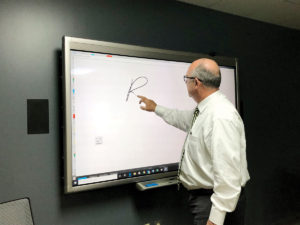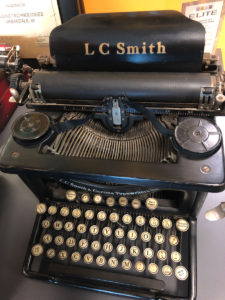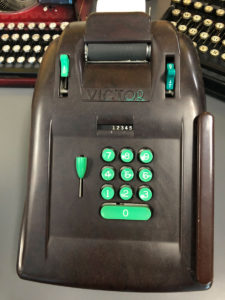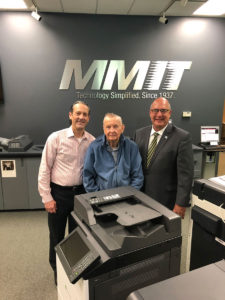The evolution of office technology
12/4/2019We have come a long way since carbon paper.

Pat Pithan, director of sales and consulting at MMIT Business Solutions in Urbandale, shows how one of the interactive whiteboards the company sells works.
Technology is constantly changing, which means office equipment and devices have continually evolved through the years. With that evolution has come the extinction of some equipment, changes in others, and the creation of many new products that have sped up the business world and made today’s office operations quicker and more efficient.
“I can tell you that technology has changed immensely,” says Marilyn Leek, the director of procurement at Simpson College in Indianola.
Leek has worked at Simpson for 50 years and, during that time, has seen devices become extinct, others be transformed, and some be invented during that timeframe. Each advance has made the workplace more efficient, modified the communication process and reduced the consumption of paper.
Technological evolutions have also led to new business trends. Organizations can connect to teams and colleagues across the country and the globe to conduct business on an international level. Employees no longer need to work in a physical office because they have the tools at their fingertips to work from anywhere remotely.
Today’s office doesn’t look like it did when Leek first began, or even 20 years ago. Typewriters and large desktop computers have been replaced with hand-held devices and smart boards with information that is transferred and stored in a digital cloud instead of on paper or a hard drive. Face-to-face meetings have been replaced with videoconferencing technology tools that allow participants to look at the same presentation without being in the same room.
Telephones have more features than ever before. The creation of email replaced many memos and letters sent through the U.S. Postal Service. Communication is faster and happens in more ways.
“It’s changed the way you communicate internally and the way you communicate externally,” Leek says. “It has made communication easier, in my opinion.”
All of these advancements have led to higher expectations in the workplace. Some employers expect their employees and other colleagues to be available around the clock. Likewise, customers can call or email any time of day and often want an immediate response.
Technology advisers say more changes are likely on the horizon as businesses adapt to new tools and technology to build their global organizations.
Here’s a look at some of the biggest changes in office technology from the 1950s through today.
Overhead projectors
While the first overhead projectors were invented in the mid- to late-1800s, they weren’t widely available until after World War II and in the 1950s when schools and businesses started to use them. The OHP used a light to project an enlarged image on a screen. The images were printed or hand-written onto page-size sheets of transparent plastic film called “foils.” Traditional overhead projectors were slowly phased out and completely gone by the 2010s with the invention of lamp-less projectors that use lasers and are essentially maintenance free.
Computers
The office world was forever changed when the first microcomputer was introduced to the small-business sector in the 1970s. The technology gave larger corporate entities the opportunity to better analyze business data. The machines, called personal computers, also eliminated redundancies in the workforce.
The introduction of computers to the Simpson College campus in the late 1970s and early 1980s allowed employees to produce financial statements more quickly.
Personal computers became more predominant in the workplace by the 1980s and created a demand for new jobs such as computer technicians, application specialists, network technicians and microcomputer support technicians.
In the 1990s, the Internet ushered in a new age of information in which businesses used the Internet, and therefore their computers, to do even more in the areas of customer support, Internet marketing, e-commerce and more. More software- and Internet-related jobs were created such as web developers, Internet marketing specialists, Internet consultants and information management specialists.
While the first laptop computers were released in the 1980s, their popularity increased in the 1990s because more models were released and prices dropped.

This LC Smith typewriter from the 1920s and ’30s is similar to the ones sold and serviced by MMIT Business Solutions in Urbandale.
Today, computers come in all shapes and sizes and are inside of almost every electronic device as the Internet of Things makes devices interconnected so they may work with each other. For example, each copier at Simpson College is monitored remotely. MMIT Business Solutions, an Urbandale company that provides printing equipment, network design solutions and IT services and support, monitors each copier and notes when the toner is down to 25 percent. A replacement is automatically ordered and sent directly to the operator for that copier. Previously, Leek ordered toner when it ran out and had to wait for it to be mailed to the school.
Pagers
Pagers were a popular way in the 1980s and 1990s to let employees know they’re trying to be reached. The pager would beep with the name and number of the person trying to contact the individual who would then have to use a payphone or a landline to call. Pagers became mostly extinct by the 2000s as more individuals relied on cell phones to receive and make immediate calls.
Tablets
A few companies dabbled in the creation of a tablet device in the late 1980s, but they wouldn’t launch in popularity and accessibility for another five to 10 years. Apple, in 1993, launched its first Personal Device Assistant, a tablet-style device that had a few applications but mostly worked as a calendar with a to-do list. It had a stylus to write on the screen. In 1997, the Palm Pilot was released and was considered to be in-between a cell phone and a laptop.
In 2010, Apple released its first iPad, which launched the popularity of tablets. The ease of both the tablet and laptop then started to replace desktop computers, typewriters and paper. They could be used to email, create spreadsheets and presentations, and much more. Tablets continue to develop in popularity and sophistication.
Telephones
From the switchboard to the rotary dial phone, the telephone had already undergone a series of updates to make it easier and faster to use, but the invention of the cellular telephone in the 1990s changed communication forever.
The first car phones and bag phones were created in the 1980s. The phones were held inside a bag that often plugged into a cigarette lighter and allowed the user to make calls on the go.
The ability to communicate and access data changed forever with the invention of the first smart phones in the 1990s that allowed individuals to make telephone calls and access emails and the Internet all with a handheld device.
Smart phones continue to add more applications that do more for individuals as well as businesses. As the camera and microphone/audio recording features grow more sophisticated, most business people can now operate entirely using their handheld device.
Fax machines/copiers
The use of fax machines, which have been available for several decades, peaked in the 1980s when it allowed businesses to send paper communications and images through telephone lines. It became one of the first universal methods of communication with images being sent to any place on a telephone line.
Standalone fax machines have gone to the technology gravesite, says Dominic Tucci, a customer care agent with Midwest Office Technology who has worked in the industry for 29 years. He says he hasn’t sold a fax machine in about a decade.
Fax machines have gone away because copiers have become more sophisticated and now do the job of multiple devices.

This Wales adding machine was donated to MMIT Business Solutions and would have been used for accounting in the 1920s.
When Leek first came to Simpson College in the 1960s, the copiers only copied items. If she needed to send documents to a vendor, she had to copy and mail them. Today, if she needs to transmit a purchase order to a vendor, she can use one of the college’s 30 copiers. Any supporting documentation that is required can be scanned in and sent along with the order.
Most businesses now have copiers that are digital machines that print in color, as well as black and white. Most businesses want a copier that can scan, fax, copy and print from a PC or network work station, whereas the old analog machines are a walk-up and copy machine, Tucci says.
In the course of 29 years, Tucci says he’s seen three evolutions of the copier. While the cost of machines may be more, the overall cost per copy is much less because of digital efficiencies and higher-yield toner cartridges.
“There’s always something new coming out that’s quicker, faster and better,” he says.
Pat Pithan, the director of sales and consulting at MMIT, says less than a handful of the company’s clients have a standalone fax machine. Most have one that is included in their copier, though the medical industry still mostly faxes records because it’s a secure way to send documents, Pithan says.
As copiers continue to improve in multifunctional capabilities, the machines move faster, produce a better product and cost less, he says. Because they serve as a computer, concerns have arisen about security with the device since it is connected to a network, Pithan says.
Whiteboards
Whiteboards replaced blackboards and chalk by the 1990s in most schools and offices because of health concerns over allergies and the potential for chalk dust to damage computers. The boards use dry-erase markers that can be wiped away with a type of cloth and eliminate the use of paper. Many offices and schools still use whiteboards today; however, interactive whiteboards, which were introduced in the late 1990s, are becoming more popular and continue to advance. SMART Technologies introduced its first interactive whiteboard, which was an LCD screen attached to a computer, in 1991. Interactive whiteboards, introduced in the 2010s, continue to advance and allow individuals to use their fingers or a facsimile pen to write instead of markers. Files can be saved and sent directly via email.
Adding machines
Adding machines were a necessary component of office life from the 1940s and helped make calculations for bookkeeping. The first machines only added. Later machines also subtracted. Digital adding machines added more features and could also divide and multiply calculations. They also had a paper tape that could be reviewed to check a calculation.
MMIT sold ribbons for adding machines and serviced them until calculators took over in the 1970s. By the 1980s, personal computers did most office computing. Older adding machines were phased out of most offices by the early 2000s.
Email started to hit its high when individuals heard the tone of “You’ve Got Mail” from their computer inbox in the 1990s. Email revolutionized the workplace as documents were no longer needed to be printed and mailed. Workers also had an alternative to faxing and could now send information in a matter of seconds. Email also replaced the Rolodex, as workers could input contact information into their email contacts.
Data storage
Floppy disks and external hard drives have been replaced with small USB drives that hold gigabytes of data along with invisible cloud storage methods that allow businesses to eliminate paper copies for more permanent storage of data.
Today, Leek, who manages Simpson College’s credit card program, can use the school’s website and copy all of the emails of a specific group of cardholders to send them a message.
“It’s much more efficient,” she says.
How technology drove one company to change
Jerry Minor, 92, started replacing ribbons in typewriters and adding machines in the 1940s for his dad’s company, now MMIT Business Solutions in Urbandale.
His father, Gilbert, started the company in 1937 when he decided to branch off to create his own business selling typewriters, adding machines and the supplies to service them.
“That was a big part of the typewriter business, to put the ribbons on the machines because the secretaries didn’t want to get their hands dirty,” Jerry recalls.
Jerry graduated from Dowling High School, joined the Navy and then graduated from college. He joined his father’s business in 1950. Adding machines were a necessity for business, but, even then, companies such as Victor were making new machines that were smaller and less clumsy.
The Minors’ company had to keep abreast of the newest machines while still serving and cycling out the old ones. LC Smith and Royal were popular typewriter companies.
By the 1950s, copy machines were starting to emerge with more popularity and convenience. Earlier methods and machines existed, but the American Photocopy Equipment Co. (APECO) introduced a new concept of an office copier. By 1952, MMIT added copiers to the equipment it was selling.

Tom Minor, the current family owner of MMIT Business Solutions, left, stands with his father Jerry Minor, the second-generation of the family to own the company, and Pat Pithan, the director of sales and consulting, among the display of copiers the company sells, which is still their largest source of revenue.
APECO assured the Minors that there was a demand for copiers in the business world. They sent the men a box of potential leads for their salesmen.
“It was a hard sell at first because people would say, ‘Why do I need a copier?’ ” Jerry recalls.
At the time, many insurance companies had a camera they used to take pictures and make copies of important documents. The idea of the copier took hold. Then other companies jumped on board, and there were more models to offer. MMIT didn’t have much competition in the Des Moines area until Xerox introduced a machine that utilized the electrostatic method, so users no longer had to clean and refill a tank. Larger companies started buying the dry machines.
By the 1960s, MMIT still sold Victor adding machines, but copiers had become a larger part of their sales. Copiers kept improving and getting bigger and better.
“We just grew with the industry,” Jerry recalls. “It was our main business because the machines needed a lot of service. You’ll sell maintenance contracts and supply the paper and toner.”
Meanwhile, typewriters advanced to portable ones for travel to school or work. IBM developed an electric typewriter. The introduction of computers meant a keyboard similar to that of the typewriter, which was familiar to office people, but it soon meant that there was no longer a need for typewriters.
Copiers continued to advance through the years into the 1990s when they became digital. Not only could office people use them to copy, but they could also print to the copier. Soon, scanners were added, and copiers could staple, punch holes and make reports. They also took over faxing capabilities, which made them a true multifunctional device.
Office printing overall has decreased with the increase in electronic transmission and storage of documents, says Pithan. While copier sales and service of copiers is still 90 percent of the company’s revenue, it’s looking to the future of office technology.
Because technology changes so frequently, the company trains its sales staff once a week on the newest products and updates. Sometimes this includes training from manufacturer representatives. The products MMIT sells are also hanging. Interactive displays and boards are now part of the product offerings.
In the early 2010s, the company branched out into managed network services and now offers IT support for small businesses. Pithan says this is a large area of future business growth, as MMIT develops into more of a technological solutions company. Instead of only offering equipment such as copiers and fax machines, the company is now including the services for the entire technology infrastructure of a business.
Jerry Minor, who retired in 1992, has personally seen much of this change through the years. His son Tom is now the third generation of the family to run the company. Jerry fondly recalls the past but continues to be excited about what future technology will bring with paperless devices.
“We have come a long way from carbon paper,” says Jerry. ♦




















